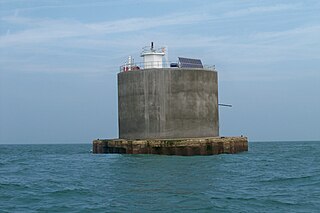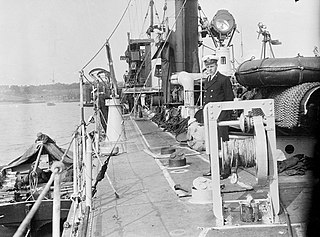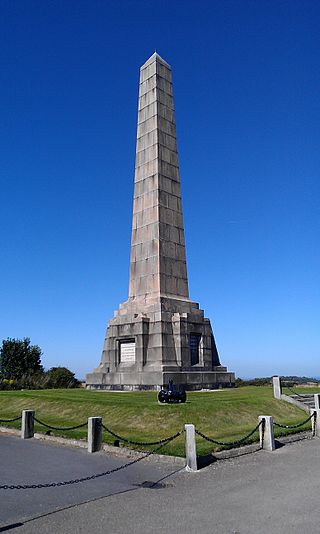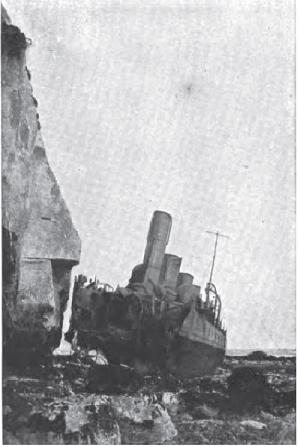
The first HMS Zulu was a Tribal class destroyer launched 16 September 1909 at Hawthorn Leslie Shipyard and commissioned in March 1910. She was mined during the First World War, on 27 October 1916 off Dover in a minefield lain by the Imperial German submarine UC-1. Her stern was blown off and sank, but the forward section remained afloat. It was towed into port and attached to the stern of Nubian, which had been torpedoed, to form a new destroyer named HMS Zubian.

The Nab Tower was a tower planned for anti-submarine protection in the Solent in World War I. It was sunk over the Nab rocks east of the Isle of Wight to replace a lightship after the war, and is a well-known landmark for sailors as it marks the deep-water eastern entry into the Solent.
Guy Anson Maunsell was the British civil engineer responsible for the design of the World War II Naval sea forts and Army forts used by the United Kingdom for the defence of the Thames and Mersey estuaries.

Constructed using light steel nets, indicator nets were often anchored at various depths to the sea bed around Allied naval bases during both world wars. They were intended to entangle U-boat traffic of the enemy, even though the submarines often managed to disentangle themselves and escape before being blown up by depth charges.

HMS Laforey was the lead ship of her class of destroyer built for the Royal Navy. Launched a year before the First World War began, she was attached to the Dover Patrol. Laforey saw action in several engagements with German torpedo boats, including the Battle off Noordhinder Bank and the action of 17 March 1917. Laforey was sunk in 1917 by a British mine after escorting several freighters to France. She was named for Francis Laforey, captain of HMS Spartiate at the Battle of Trafalgar in 1805.

HMS Viking was a Tribal-class destroyer of the Royal Navy launched in 1909 and sold for scrap in 1919. She was the only destroyer ever to have six funnels.

The Dover Patrol and later known as the Dover Patrol Force was a Royal Navy command of the First World War, notable for its involvement in the Zeebrugge Raid on 22 April 1918. The Dover Patrol formed a discrete unit of the Royal Navy based at Dover and Dunkirk for the duration of the First World War. Its primary task was to prevent enemy German shipping—chiefly submarines—from entering the English Channel en route to the Atlantic Ocean, thereby obliging the Imperial German Navy to travel via the much longer route around Scotland which was itself covered by the Northern Patrol.

The Mediterranean U-boat Campaign in the Mediterranean Sea was fought by Austria-Hungary and German Empire against the Allies during World War I. It was characterised by the ability of the Central Powers to raid with near impunity during the first years of the war, causing substantial shipping losses, until the introduction of the convoy system allowed the Allies to drastically cut their losses from 1917 on.

A naval drifter is a boat built along the lines of a commercial fishing drifter but fitted out for naval purposes. The use of naval drifters is paralleled by the use of naval trawlers.
SM UC-44 was a German Type UC II minelaying submarine or U-boat in the German Imperial Navy during World War I. The U-boat was ordered on 20 November 1915 and was launched on 10 October 1916. She was commissioned into the German Imperial Navy on 4 November 1916 as SM UC-44. In 6 patrols UC-44 was credited with sinking 28 ships, either by torpedo or by mines laid. UC-44 was sunk by the detonation of one of her own mines off the Irish coast at position 52°07′N6°59′W on 4 August 1917; its commander, Kurt Teppenjohanns, was the only survivor. UC-44's wreck was raised by the Royal Navy in September 1917 and later broken up.

The U-boat Campaign from 1914 to 1918 was the World War I naval campaign fought by German U-boats against the trade routes of the Allies. It took place largely in the seas around the British Isles and in the Mediterranean. The German Empire relied on imports for food and domestic food production and the United Kingdom relied heavily on imports to feed its population, and both required raw materials to supply their war industry; the powers aimed, therefore, to blockade one another. The British had the Royal Navy which was superior in numbers and could operate on most of the world's oceans because of the British Empire, whereas the Imperial German Navy surface fleet was mainly restricted to the German Bight, and used commerce raiders and unrestricted submarine warfare to operate elsewhere.

The Atlantic U-boat campaign of World War I was the prolonged naval conflict between German submarines and the Allied navies in Atlantic waters—the seas around the British Isles, the North Sea and the coast of France.

SM U-21 was a U-boat built for the Imperial German Navy shortly before World War I. The third of four Type U-19-class submarines, these were the first U-boats in German service to be equipped with diesel engines. U-21 was built between 1911 and October 1913 at the Kaiserliche Werft in Danzig. She was armed with four torpedo tubes and a single deck gun; a second gun was added during her career.

The Battle of Dover Strait that occurred on 26–27 October 1916 was a naval battle of the First World War between Great Britain and the German Empire. Two and a half flotillas of German torpedo boats from the Flanders Flotilla launched a raid into the Dover Strait in an attempt to disrupt the Dover Barrage and destroy whatever Allied shipping could be found in the strait.

The convoy—a group of merchantmen or troopships traveling together with a naval escort—was revived during World War I (1914–18), after having been discarded at the start of the Age of Steam. Although convoys were used by the Royal Navy in 1914 to escort troopships from the Dominions, and in 1915 by both it and the French Navy to cover their own troop movements for overseas service, they were not systematically employed by any belligerent navy until 1916. The Royal Navy was the major user and developer of the modern convoy system, and regular transoceanic convoying began in June 1917. They made heavy use of aircraft for escorts, especially in coastal waters, an obvious departure from the convoy practices of the Age of Sail.
HMS Leven was a Fairfield "30-knotter" destroyer of the Royal Navy, later classified as part of the C class. It was built in 1898–1899, and served with the Royal Navy through to the First World War, sinking a German U-boat in 1918. Leven was sold for scrapping in 1920.

The Dover Barrage was an underwater blockade by England of German submarines attempting to use the English Channel during World War I. The barrage consisted of explosive mines and indicator nets. A similar barrage was used in World War II.
HMS Murray was a Royal Navy Admiralty M-class destroyer. Ordered before the outbreak of war, she was therefore the first of her class to enter operation during the early months of the First World War. She was also the first vessel of the Royal Navy to carry the name HMS Murray.

The Anti-Submarine Division its original name, was the former anti-submarine warfare, planning and prevention directorate of the Admiralty Department from 1912 to 1963.
HMS Melpomene was a Medea-class destroyer of the British Royal Navy. She was one of four destroyers, of similar design to the British M-class ordered by Greece in June 1914, which the British purchased during construction owing to the outbreak of the First World War.















